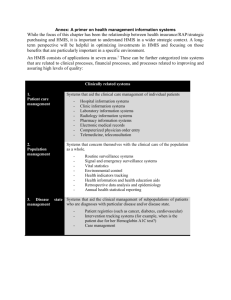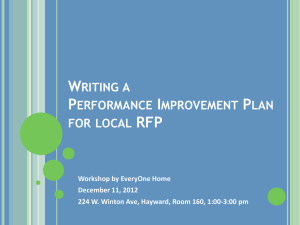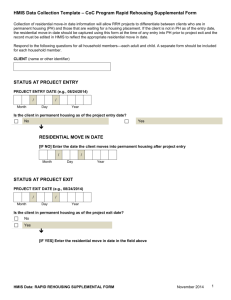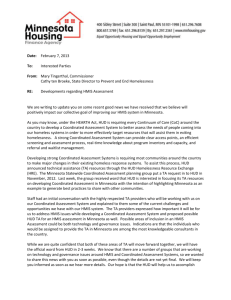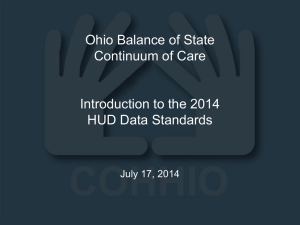ShareLink HMIS Data Quality Plan
advertisement
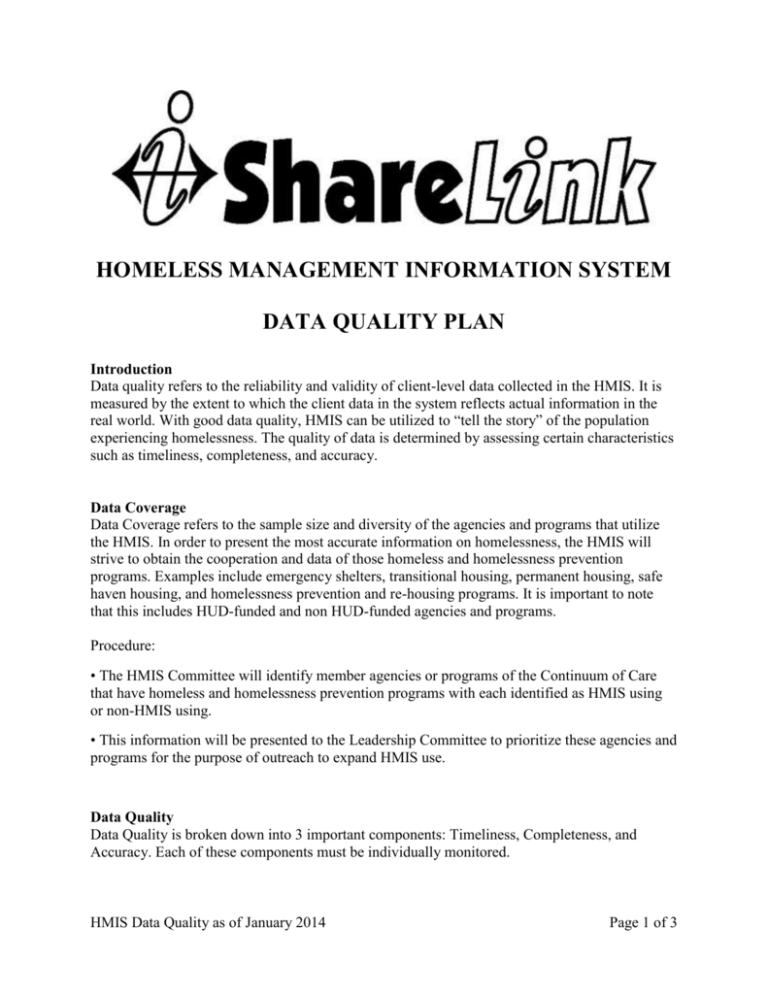
HOMELESS MANAGEMENT INFORMATION SYSTEM DATA QUALITY PLAN Introduction Data quality refers to the reliability and validity of client-level data collected in the HMIS. It is measured by the extent to which the client data in the system reflects actual information in the real world. With good data quality, HMIS can be utilized to “tell the story” of the population experiencing homelessness. The quality of data is determined by assessing certain characteristics such as timeliness, completeness, and accuracy. Data Coverage Data Coverage refers to the sample size and diversity of the agencies and programs that utilize the HMIS. In order to present the most accurate information on homelessness, the HMIS will strive to obtain the cooperation and data of those homeless and homelessness prevention programs. Examples include emergency shelters, transitional housing, permanent housing, safe haven housing, and homelessness prevention and re-housing programs. It is important to note that this includes HUD-funded and non HUD-funded agencies and programs. Procedure: • The HMIS Committee will identify member agencies or programs of the Continuum of Care that have homeless and homelessness prevention programs with each identified as HMIS using or non-HMIS using. • This information will be presented to the Leadership Committee to prioritize these agencies and programs for the purpose of outreach to expand HMIS use. Data Quality Data Quality is broken down into 3 important components: Timeliness, Completeness, and Accuracy. Each of these components must be individually monitored. HMIS Data Quality as of January 2014 Page 1 of 3 Timeliness: Programs will enter data in a timely fashion so that the system will reflect current information and status. Standards: Emergency shelters will enter clients with their demographics and shelter stay information within 5 days of shelter check-in. This check-out will also be recorded within 5 days. Other programs will record clients, their demographics and program entry/exits within 5 days of entry and 5days of exit. Programs will also update client information on their current population according to their particular program requirements. Completeness The minimum data elements will comply with the Homeless Management Information System (HMIS) Data and Technical Standards as set forth by U.S. Housing and Urban Development (HUD) in March 2010. These standards will be updated to comply with future HUD data standards changes. All data entry must be captured using a HMIS Staff approved workflow. Most programs are required to use Entry / Exits for their workflow while some programs may be instructed to use a service transaction model or bed management model based on their program type. The HUD standards list Universal Data Elements to be gathered on all clients, Program Specific Data Elements to be gathered by programs where required on their clients, and Optional Data Elements for a program to use at its discretion. In addition, programs will sometimes require their own custom fields to meet their program needs. For each client, each program will collect and enter in HMIS all data elements that were selected for use according to standards and program need. All agencies and programs across the continuum must provide HMIS Staff with complete the Program Descriptor Data. This information is provided on a per-program basis and must be reviewed annually. Standards: 100% of clients will be entered into HMIS Each data element in use by a program will be completed in at least 95% of the program’s clients. The Provider’s data will be completed in all fields and will be reviewed at least annually. HMIS Data Quality as of January 2014 Page 2 of 3 Accuracy Client data will be entered accurately to reflect the information provided by the client during intake, arrival, departure, interview or case management. Staff will further explain the questions to clients where necessary for the client to have sufficient understanding to provide the information. Standard: At least 95% of data entered into HMIS will match program client files selected for comparison. Training All HMIS system users will be trained on HMIS purpose, system access, security, privacy, and data entry as these relate to their programs by qualified HMIS trainers. Follow-up training is available upon request or where data quality indicates that additional training is necessary for standards to be met. Advanced training is also offered on selected topics such as reporting. Standards: All HMIS users will be trained in system use by qualified HMIS trainers. All HMIS users will sign a HMIS user policy agreement where they agree to comply with specific system use requirements that relate to access, security, privacy, and data quality when they are granted HMIS access and again yearly. Monitoring Data Quality Monitoring Data Quality is a shared responsibility between the participating agency, HMIS Staff and the HMIS Committee. Each of the elements of data quality will be monitored. HMIS staff will provide data quality reports quarterly to each agency using HMIS system monitoring reports. HMIS Staff will provide recommendations for improvement of data quality to programs based on the information found during monitoring. The programs will consider the information provided and take appropriate steps to improve data quality. HMIS Staff will also notify an agency of any issues that arise between official monitoring reports. The CoC will review programs’ data quality at least annually or as necessary to respond to significant issues or changes. HMIS Data Quality as of January 2014 Page 3 of 3
